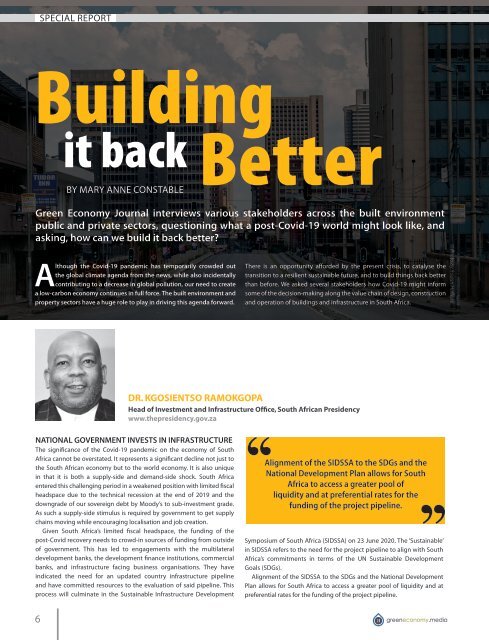Green Economy Journal Issue 41
You also want an ePaper? Increase the reach of your titles
YUMPU automatically turns print PDFs into web optimized ePapers that Google loves.
SPECIAL REPORT<br />
Building<br />
it back<br />
BY Mary Anne Constable<br />
Better<br />
<strong>Green</strong> <strong>Economy</strong> <strong>Journal</strong> interviews various stakeholders across the built environment<br />
public and private sectors, questioning what a post-Covid-19 world might look like, and<br />
asking, how can we build it back better?<br />
Although the Covid-19 pandemic has temporarily crowded out<br />
the global climate agenda from the news, while also incidentally<br />
contributing to a decrease in global pollution, our need to create<br />
a low-carbon economy continues in full force. The built environment and<br />
property sectors have a huge role to play in driving this agenda forward.<br />
There is an opportunity afforded by the present crisis, to catalyse the<br />
transition to a resilient sustainable future, and to build things back better<br />
than before. We asked several stakeholders how Covid-19 might inform<br />
some of the decision-making along the value chain of design, construction<br />
and operation of buildings and infrastructure in South Africa.<br />
Photo by Ihsaan Haffejee<br />
DR. KGOSIENTSO RAMOKGOPA<br />
Head of Investment and Infrastructure Office, South African Presidency<br />
www.thepresidency.gov.za<br />
NATIONAL GOVERNMENT INVESTS IN INFRASTRUCTURE<br />
The significance of the Covid-19 pandemic on the economy of South<br />
Africa cannot be overstated. It represents a significant decline not just to<br />
the South African economy but to the world economy. It is also unique<br />
in that it is both a supply-side and demand-side shock. South Africa<br />
entered this challenging period in a weakened position with limited fiscal<br />
headspace due to the technical recession at the end of 2019 and the<br />
downgrade of our sovereign debt by Moody’s to sub-investment grade.<br />
As such a supply-side stimulus is required by government to get supply<br />
chains moving while encouraging localisation and job creation.<br />
Given South Africa’s limited fiscal headspace, the funding of the<br />
post-Covid recovery needs to crowd-in sources of funding from outside<br />
of government. This has led to engagements with the multilateral<br />
development banks, the development finance institutions, commercial<br />
banks, and infrastructure facing business organisations. They have<br />
indicated the need for an updated country infrastructure pipeline<br />
and have committed resources to the evaluation of said pipeline. This<br />
process will culminate in the Sustainable Infrastructure Development<br />
Alignment of the SIDSSA to the SDGs and the<br />
National Development Plan allows for South<br />
Africa to access a greater pool of<br />
liquidity and at preferential rates for the<br />
funding of the project pipeline.<br />
Symposium of South Africa (SIDSSA) on 23 June 2020. The ‘Sustainable’<br />
in SIDSSA refers to the need for the project pipeline to align with South<br />
Africa’s commitments in terms of the UN Sustainable Development<br />
Goals (SDGs).<br />
Alignment of the SIDSSA to the SDGs and the National Development<br />
Plan allows for South Africa to access a greater pool of liquidity and at<br />
preferential rates for the funding of the project pipeline.<br />
6 greeneconomy.media


















